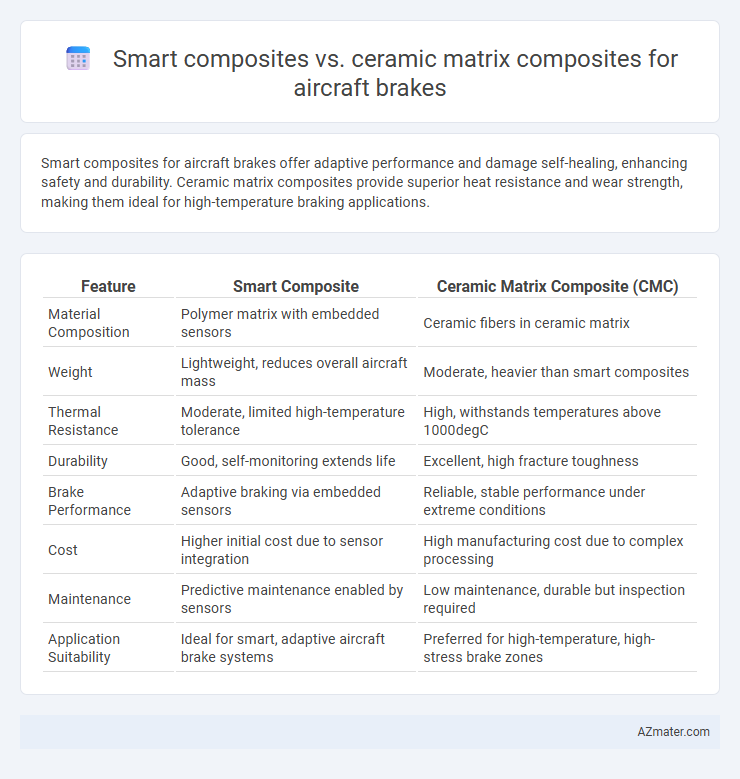Smart composites for aircraft brakes offer adaptive performance and damage self-healing, enhancing safety and durability. Ceramic matrix composites provide superior heat resistance and wear strength, making them ideal for high-temperature braking applications.
Table of Comparison
| Feature | Smart Composite | Ceramic Matrix Composite (CMC) |
|---|---|---|
| Material Composition | Polymer matrix with embedded sensors | Ceramic fibers in ceramic matrix |
| Weight | Lightweight, reduces overall aircraft mass | Moderate, heavier than smart composites |
| Thermal Resistance | Moderate, limited high-temperature tolerance | High, withstands temperatures above 1000degC |
| Durability | Good, self-monitoring extends life | Excellent, high fracture toughness |
| Brake Performance | Adaptive braking via embedded sensors | Reliable, stable performance under extreme conditions |
| Cost | Higher initial cost due to sensor integration | High manufacturing cost due to complex processing |
| Maintenance | Predictive maintenance enabled by sensors | Low maintenance, durable but inspection required |
| Application Suitability | Ideal for smart, adaptive aircraft brake systems | Preferred for high-temperature, high-stress brake zones |
Introduction to Aircraft Brake Materials
Aircraft brake materials must withstand extreme temperatures, high friction, and mechanical stress during landing and taxiing operations. Smart composites offer adaptive properties with embedded sensors for real-time performance monitoring, while ceramic matrix composites (CMCs) provide superior heat resistance and wear durability at elevated temperatures. The selection between smart composites and CMCs depends on balancing thermal stability, weight reduction, and proactive maintenance capabilities in modern aircraft brake systems.
Overview of Smart Composites
Smart composites integrate sensors and actuators within fiber-reinforced matrices, enabling real-time monitoring and adaptive responses to stress and temperature changes in aircraft brakes. These composites enhance safety and performance by providing self-diagnostic capabilities and improving wear resistance through embedded nanomaterials. Unlike ceramic matrix composites, which primarily offer high-temperature tolerance and rigidity, smart composites deliver multifunctional properties crucial for advanced braking systems.
Understanding Ceramic Matrix Composites (CMCs)
Ceramic Matrix Composites (CMCs) consist of ceramic fibers embedded in a ceramic matrix, providing exceptional heat resistance and lightweight properties essential for high-performance aircraft brakes. These composites offer superior thermal stability and wear resistance compared to traditional smart composites, enabling aircraft brakes to withstand extreme temperatures and mechanical stresses during landing and taxiing. Understanding the microstructure and fracture toughness of CMCs is critical for optimizing brake performance and durability in advanced aviation applications.
Key Performance Criteria for Aircraft Brakes
Smart composites offer adaptive thermal management and enhanced crack detection capabilities, improving the reliability and safety of aircraft brakes compared to ceramic matrix composites (CMC). Ceramic matrix composites provide superior high-temperature resistance and wear durability essential for brake discs under extreme friction and heat conditions. Key performance criteria for aircraft brakes prioritize thermal conductivity, fracture toughness, and weight reduction, where smart composites excel in real-time monitoring while CMCs deliver consistent structural integrity during repeated braking cycles.
Mechanical Strength Comparison
Smart composites for aircraft brakes exhibit enhanced mechanical strength through adaptive load distribution and self-sensing capabilities, improving durability under cyclic thermal and mechanical stresses. Ceramic matrix composites (CMCs) provide superior high-temperature resistance and maintain structural integrity with high tensile strength and fracture toughness, crucial for braking performance in extreme conditions. Comparative studies reveal that while CMCs excel in static mechanical strength and thermal stability, smart composites offer dynamic reinforcement and real-time damage detection, enhancing safety and lifespan in aircraft brake applications.
Thermal Stability and Heat Resistance
Smart composites in aircraft brakes offer enhanced thermal stability through adaptive heat dissipation mechanisms, maintaining integrity under rapid temperature fluctuations. Ceramic matrix composites (CMCs) provide superior heat resistance withstanding continuous high-temperature exposure up to 1200degC, crucial for reducing brake fade during intense braking. The integration of CMCs improves brake durability and performance by maintaining structural stability and resisting thermal shock better than traditional smart composites.
Wear Resistance and Longevity
Smart composites for aircraft brakes integrate adaptive materials that enhance wear resistance by responding dynamically to temperature changes, thereby reducing thermal degradation. Ceramic matrix composites (CMCs) exhibit superior inherent wear resistance due to their high hardness and thermal stability, supporting extended service life under extreme braking conditions. The longevity of CMCs surpasses traditional smart composites by maintaining structural integrity and minimizing wear at elevated temperatures commonly experienced during aircraft deceleration.
Weight and Fuel Efficiency Impact
Smart composites in aircraft brakes offer significant weight reductions compared to traditional ceramic matrix composites (CMCs), directly contributing to improved fuel efficiency by lowering overall aircraft mass. The enhanced durability and self-sensing properties of smart composites allow for optimized brake performance without adding significant weight, which helps maintain fuel economy during operation. In contrast, while ceramic matrix composites provide high-temperature resistance and structural integrity, their heavier mass slightly compromises the potential fuel savings achievable by lighter smart composite materials.
Cost Analysis and Manufacturing Processes
Smart composites in aircraft brakes offer cost advantages due to simpler manufacturing processes like automated fiber placement and resin transfer molding compared to ceramic matrix composites (CMCs), which involve high-temperature sintering and complex powder processing. The raw materials for smart composites, such as carbon or glass fibers combined with polymer matrices, generally incur lower expenses than the specialized ceramics and reinforcements required for CMCs. Maintenance and lifecycle costs also favor smart composites because their repair and replacement procedures are less labor-intensive and require less specialized equipment than those for ceramic matrix composites.
Future Trends in Aircraft Brake Materials
Smart composites in aircraft brakes incorporate embedded sensors and adaptive materials, enabling real-time condition monitoring and improved performance under varying thermal loads. Ceramic matrix composites (CMCs) offer exceptional heat resistance, low density, and high strength, making them ideal for high-temperature brake applications and reducing overall aircraft weight. Future trends emphasize hybrid materials combining smart composite intelligence with the thermal robustness of CMCs, advancing brake system efficiency, safety, and lifespan in next-generation aircraft.

Infographic: Smart composite vs Ceramic matrix composite for Aircraft brake
 azmater.com
azmater.com